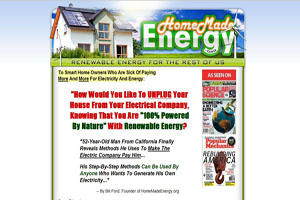The Most Power Hungry Appliances in Your Home
|
What is the #1 Reason why homeowners don't
add Wind or Solar power to their home?
$$$ COST $$$
For this reason, thousands of homeowners are learning how
make their own solar panels and windmills (wind turbines). It is amazingly
easy and doesn't require much technical knowledge. We've
reviewed the best guides available on the internet and rated
them.
2008 Top "do it yourself"
Guide
Home Made Energy
Read full Home Made Energy
Review
Top Do it Yourself Guides
Compared
|
|
When considering the use of alternative sources of energy such
as wind and solar power, it is important to understand which appliances use
the greatest amount of electricity. Generally speaking,
appliances that require 240 volt power require greater amounts of
electricity than appliances that use 120 volt electricity. If you are
wondering which appliances use 240 volt electricity, look at your
circuit breaker box and see which breakers use two slots instead of one.
The ones that use up two slots per switch use 240 volts of
electricity. The following appliances typically use
240 volts of electricity, in the order of the greatest usage:
If you are using a gas furnace, gas hot water heater, gas
dryer and gas cook stove, those appliances will not typically require large
amounts of electricity. If you are on city water, the city pays for the
pumping of water so you will not have a water pump installed in your
home.
Anything that generates heat by the use of electricity alone
use electricity in heavy doses. Heat pumps move heat from the outside air to
the inside of the house so they don't usually generate heat unless the system
is in a defrost cycle. For this reason, heat pumps are much more efficient
than electric furnaces using heat strips.
Electric dryers require amazing amounts of electricity. For an
interesting exercise, go out to your electric meter and note the difference in
'spin rate' when the dryer is turned on. Then you'll understand why some
people use clothes lines instead.
Gas heating systems require a small amount of electricity for
running the fan and various component controls. Purchasing 100% efficient wall
hung or fireplace heaters in your home might not require any electricity at
all to run. Of the 120 volt appliances, all electric
space heaters use the same amount of electricity (and in spite of all
the fancy designs) all produce the same amount of heat. They usually
require the most amount of electricity of any 120 volt appliance. This
is followed by toasters, hair dryers, circular saws, microwaves,
vacuum cleaners, refrigerators, and other motor powered devices such as mixers and food
processors. Refrigerators and freezers are next depending on the size.
The amount of power a computer requires depends on the speed of the
system and whether or not an LCD monitor is used. LCD monitors use much
less electricity than CRT's. A single light bulb uses
very little electricity. In fact, you could leave a 60 watt light bulb
on for 30 days and it would only require $3 to $4 worth of electricity.
However, when you have multiple rooms lit up, with each ceiling lamp
containing 3 or more bulbs, this can add up. Fluorescent light bulbs
last longer and use far less electricity, but they also contain mercury
and do not give you full spectrum lighting.
To test how much electricity an item uses, you can purchase an
ammeter to measure the amp draw of the appliance. You would have to find a way
to place the clamp of the ammeter around one wire that feeds the appliance
alone, or remove the cover of the circuit box and place the clamp of the
ammeter around the wire that feeds the electricity to the appliance.
To determine the wattage, multiply the voltage times the amp
draw of the appliance. For instance, 120 volts X 3 amps would be 360 watts.
Sometimes the appliance will give you the wattage on the nameplate. This can
save time and effort. The goal of learning all of this is to
determine how much energy your home requires and what kind of effect it
will have on your solar and wind power needs.
WindSolarEnergy.ORG Home
All rights reserved. Copyright ©
WindSolarEnergy.ORG 2008
|